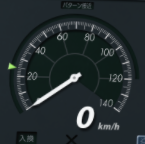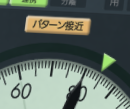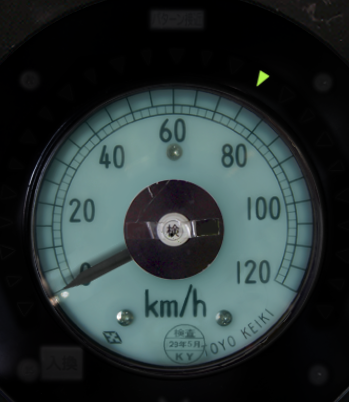Safety Systems
ATS-P

ATS-P is a safety system which, when it receives certain signals via transponders located on the track, will generate a braking curve (pattern) to prevent the train from exceeding a certain speed, or even force it to stop. The generation of this pattern is represented by the indicator "パターン接近" and the emission of a "ding".
If the train exceeds this speed, the ATS-P will automatically activate the train's brakes to bring it back under the limit. During this braking, the "常用ブレーキ" indicator is lit (and a "ding" is emitted) until the train passes below the pattern speed limit.
However, when approaching a stop signal (red light), if the speed limit is exceeded, then the ATS-P will bring the train to a complete stop via normal braking (常用ブレーキ). In this case, once at a standstill, you must set the brakes to a level B1 to B8 and then press the "ATS Reset (Service)" button (key Y) to disengage the brake and be able to continue driving to position your train properly (unless ATS Brake Reset is set to automatic in the settings).
Finally, if you're about to pass the stop signal by crossing the transponder closest to the stop signal, the ATP-P will then perform emergency braking (indicator "非常ブレーキ"). Once stationary, you must set the brakes to the emergency brake position, then press the "ATS Reset (Emergency)" button (U key) to disengage the emergency brake so that you can properly position your train (unless ATS Brake Reset is set to automatic in the settings).
ATS-Ps

Like the ATS-P, the ATS-Ps generates braking patterns to force the train not to exceed certain limits (usually before dangerous curves or switches).
The ATS-Ps is represented in the cab by a dial containing a gauge and several indicators.
The green part represents the current speed, the yellow part the limit not to be exceeded.
When a pattern is generated, the first indicator (パターン発生 - green) lights up and an audible announcement is made. From this point on, the yellow part will increase.
If you're too close to the limit, the second light (パターン接近 - orange) will come on and a little buzzer sound will be emitted to warn you to brake.
If, however, the limit is reached, the third indicator will light up (ブレーキ動作 - orange) and the train will stop automatically. Once stopped, you will then need to switch to the emergency brakes and press the "ATS Reset (Emergency)" button (U key) to be able to restart (unless ATS Brake Reset is set to automatic in the parameters).
ATS Confirmation
On lines using ATS-Ps, when you enter "Warning"/"Restricted Speed" zones (see Warning lights), an alarm may be triggered, along with a "ding dong" sound. In this case, position the gearshift on a brake level and press the "ATS Confirmation" button (unless set to automatic). This will stop the alarm.
If you don't stop the alarm within 5 seconds, the train will stop automatically and you'll have to press the "ATS Reset (Emergency)" button to restart.
The "Ding dong" must be stopped manually, once you've left the zone in question, by pressing the "Stop alarm" button.
This happens, for example, when you arrive at Nobiru station on the Senseki line.
D-ATC
The D-ATS (for Digital Automatic Train Control) is a speed control system and a modernized version of the old analog ATC systems. They were originally developed for Shinkansens (Japanese high-speed trains) because, at high speed, drivers had no time to take note of signals on the track.
This system uses information transmitted by track circuits, as well as information stored in the on-board computer's memory, to keep the train and its driver aware of possible events ahead of the train (tight curve, presence of a train in the next block, etc.).
 For trains using the D-ATC safety system, maximum speed is represented by a green arrow on the speed dial. If the maximum speed is exceeded, the train will automatically brake more or less hard to go below the limit.
For trains using the D-ATC safety system, maximum speed is represented by a green arrow on the speed dial. If the maximum speed is exceeded, the train will automatically brake more or less hard to go below the limit.

When changing speed limit, a bell sound is emitted. If the change involves a reduction in speed, the maximum speed indicator will move slowly. If the indicator above the speed dial (パターン接近 / pattern approach) is lit, then you will need to slow down until it goes out.
ATACS

ATACS works in much the same way as D-ATC, except that information is transmitted via a radio signal and not via track circuits.
